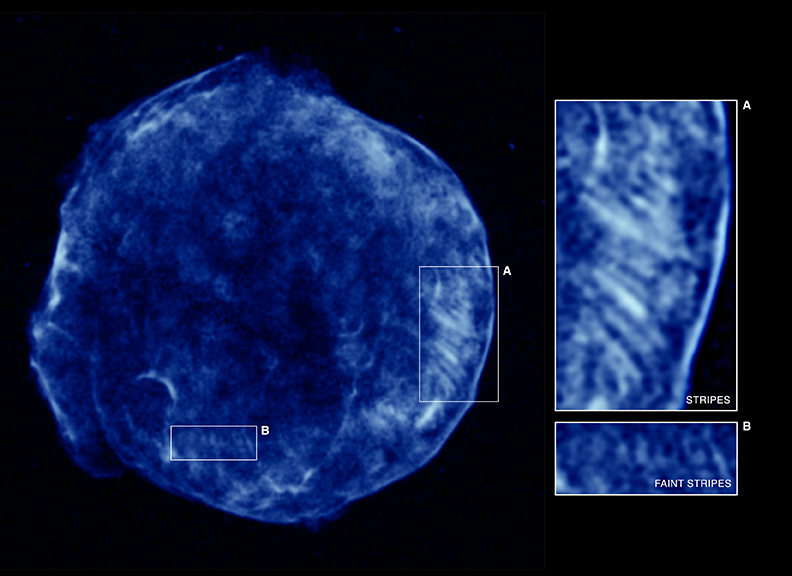
 Credit: NASA/CXC/Rutgers/K.Eriksen et al.
Credit: NASA/CXC/Rutgers/K.Eriksen et al.
Tycho Stripes
How do you organize an explosion? That seems impossible, especially if the explosion involves the complete destruction of a star. But the debris from an explosion of a star seen over 400 years ago apparently shows surprisingly regular pattern of stripes in X-rays. This debris was created by the explosion of a star that was observed from earth in 1572 (and recorded by the famous nose-less astronomer, Tycho Brahe, so it's often called "Tycho's supernova"). The explosion was produced when a white dwarf star gained too much matter from a companion star, pushing it above the Chandrasekhar limit, resulting in explosive nuclear burning of carbon in the dwarf's interior which blew the it apart in a stellar deflagration; we're not really sure what happened to the companion. But a new observation of the remnant left behind, appropriately enough by the Chandra X-ray observatory, has revealed a pattern of stripes imposed on the explosion, as shown in the X-ray image above. As you probably know, a supernova remnant is the cloud of high-velocity material ejected into space by the explosion of a star; this material initially gets heated to temperatures of millions of degrees as it collides with the rest of the gas and dust in the Galaxy, and radiates in X-rays. Studies of supernovae in X-rays help reveal details about the explosion itself, and the chemical composition of the ejected material. But the stripes seen by Chandra in Tycho's remnant are a surprise. Astronomers think these stripes represent the boundaries of motion of protons accelerated to enormous energies - more than 100 times larger than the maximum particle energy produced at the Large Hadron Collider. Similar particles may ultimately be the source of the mysterious ultra-high-energy cosmic rays detected at earth.
Published: April 4, 2011
<
HEA Dictionary ● Archive
● Search HEAPOW
● Other Languages
● HEAPOW on Facebook
● Download all Images
● Education ● HEAD
>

Each week the HEASARC
brings you new, exciting and beautiful images from X-ray and Gamma ray
astronomy. Check back each week and be sure to check out the HEAPOW archive!
Page Author: Dr. Michael F. Corcoran
Last modified Monday, 26-Feb-2024 17:47:26 EST


